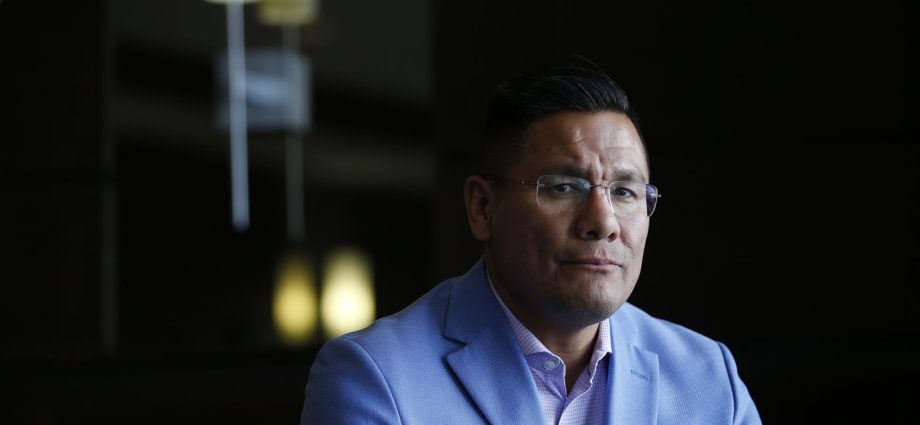How two Manitoba First Nations are controlling COVID-19 outbreaks in their communities
Chief Christian Sinclair of the Opaskwayak Cree Nation invests in cannabis companies and is photographed in Winnipeg Thursday, October 3, 2019. (John Woods / The Globe and Mail)
By Willow Fiddler, Local Journalism Initiative Reporter, The Globe and Mail
Dec 04, 2020
The outbreak started at a funeral for a young girl who died from cancer. About 200 people from the community of Pimicikamak were in attendance, including someone unknowingly infected with COVID-19. Days later, Pimicikamak Cree Nation leaders were notified about that positive case along with a family of four who also attended the funeral and all contracted the virus. The leaders sounded the alarm immediately, says Chief David Monias.
“Absolutely people are scared and people are upset,” Chief Monias said, recalling when he had to announce the first cases to the community of about 8,600 members on Oct. 24. “They said how could you let this person in or how did this person get through?”
Pimicikamak is one of a number of First Nations in Manitoba hit with recent outbreaks as COVID-19 infections almost tripled across the province in November and deaths hit record numbers.
While they represent about 10 per cent of Manitoba’s population, First Nations people make up 25 per cent of all new cases and 42 per cent of those in intensive care units, according to data from the Manitoba First Nations COVID-19 Pandemic Response Coordination Team.

The outbreak can be devastating for those living in overcrowded homes and with underlying health conditions. Nation leaders have acted swiftly to impose lockdowns and secure testing and isolation spaces – offering lessons to other communities grappling with outbreaks.
Chief Monias said Pimicikamak’s approach was to stop the spread of the coronavirus by restricting people to their homes, shutting down public places with the exception of essential services and sending people who tested positive, and those who were in contact with them, to Winnipeg to isolate.
“That was the main message, to stop the spread. And the only way to stop the spread is actually by shutting down mobility of people in our community,” Chief Monias said.
A rapid response team made up of primarily First Nations doctors, nurses and other health professionals was deployed to conduct testing and contact tracing. Chief Monias said the community’s own pandemic team is made up of about 23 people including emergency response workers, doctors, nurses, elected leadership, social workers and others who ensure supports are in place for people to safely isolate and lockdown.
By Oct. 29, the province had issued a public-health order supporting the community’s measures to close schools, businesses and restrict gatherings outside of households as the remote community moved into critical red alert on the province’s pandemic response system.
Chief Monias says anyone who tested positive along with their contacts were sent to isolate in Winnipeg hotels, “just in case.” More than 200 people identified as contacts were sent to isolate in a Winnipeg hotel covered by the Red Cross and 70 confirmed cases isolated in a separate hotel provided by the federal government.
“We did not ascertain the difference between close contact and contact, to us if you’re a contact, you’re contact and should be isolated. That’s just to make sure that you don’t spread it,” he said.
Checkpoints were set up in five different areas of the community to monitor traffic and a shopping schedule implemented for residents.
The community’s personal care home was restricted to staff only, who themselves were instructed to limit contacts outside of the home. Signs were also put up outside elders’ homes. “An elder lives here, is vulnerable, please do not enter,” they read.
Chief Monias says it took five weeks to resolve all 70 COVID-19 cases from the outbreak. There’s no more community transmission, but they are now trying to contain additional cases that have popped up since, including in dialysis patients who have been staying in Thompson while they get treatment.
Pimicikamak isn’t the only First Nation to successfully beat back an outbreak.
About a week after the funeral in Pimicikamak, people attending a funeral in Opaskwayak Cree Nation were exposed to the virus, leading to community transmission.
The spread within the community reached all 28 residents and 13 staff from the Rod McGillivary Memorial Care Home, and one resident died as a result.
Onekanew (Chief) Christian Sinclair of Opaskwayak says they had to move quickly to contain the spread of the virus, which has infected close to 200 people so far.
Onekanew Sinclair said they requested military support from the federal government following the death of the care-home resident. A team of 12 people from CFB Edmonton and Shilo stayed on the ground at the residence for about 10 days, supporting frontline staff, some of whom slept there and worked around the clock, Onekanew Sinclair said.
He said one resident was sent to an intensive-care unit in Winnipeg and the rest were isolated and treated within the care home.
“We are proud and very happy, relieved to announce that they have all fully recovered and are now able to move about freely within the care home again instead of being isolated in their rooms,” Onekanew Sinclair said.
The community has more than 3,000 living on-reserve and is a service hub for surrounding communities in the region, which means checkpoints have been established at main access points to monitor traffic going in and out. They remain on a lockdown with schools closed and students doing remote learning from home.
Opaskwayak converted their 60-room hotel and another 45-bed facility for isolation units but Onekanew Sinclair says there are cases where entire families have become infected and opt to stay home.
Subscribe to our newsletter.
“We have to do what we can with our resources available,” Onekanew Sinclair said. “And when it’s time we’ll call on the federal government as our treaty partner for assistance where needed, as needed.”

